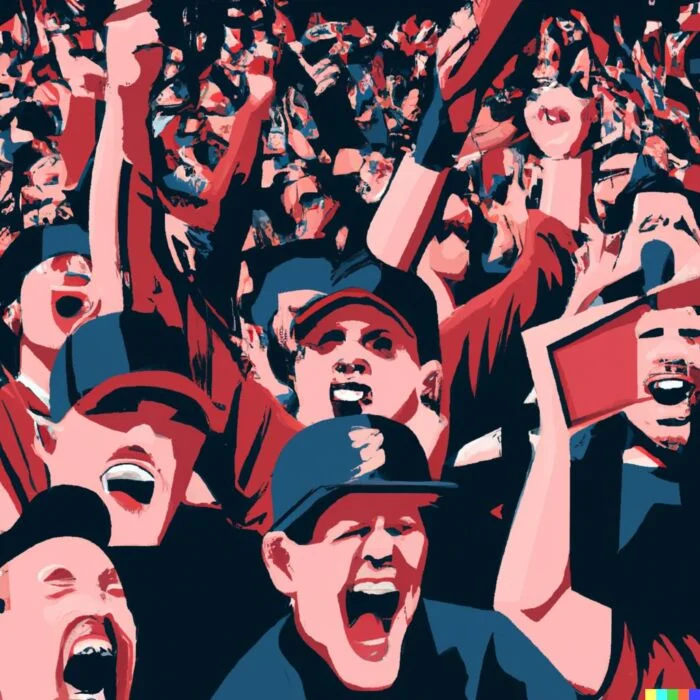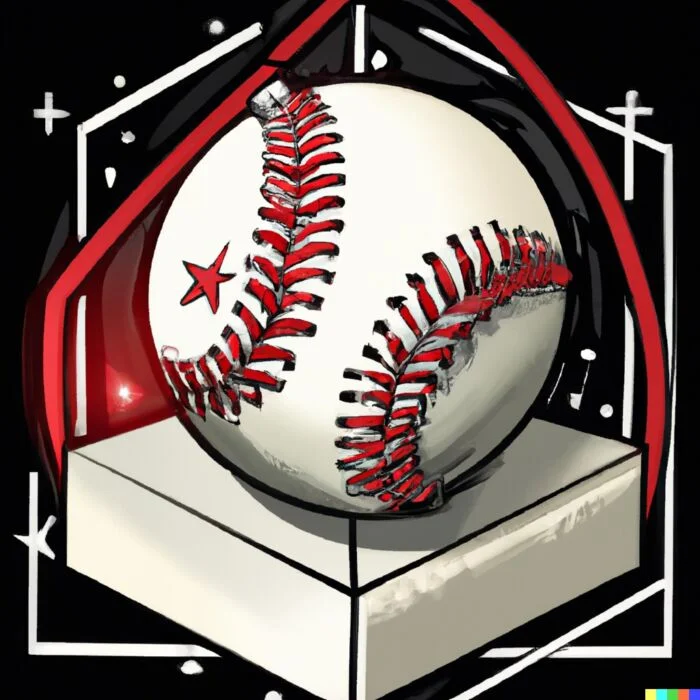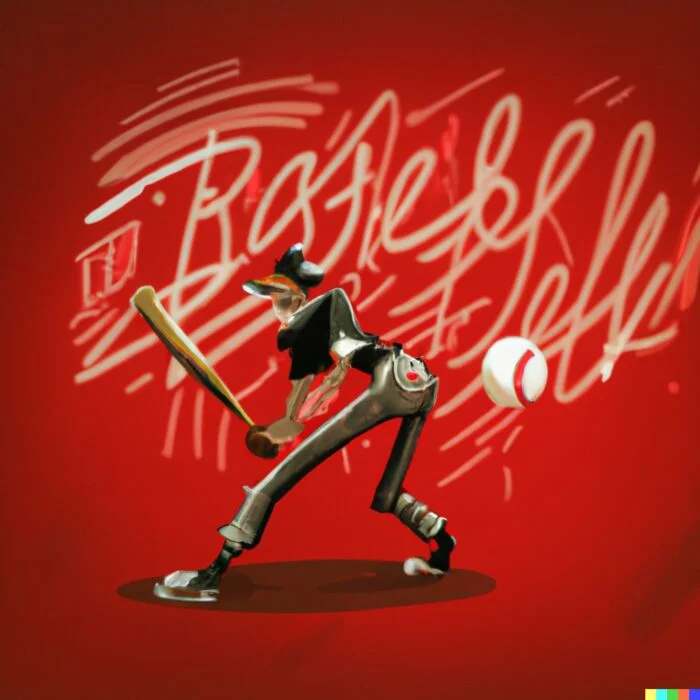The lessons I learned playing fantasy baseball as a kid taught me how to be a better investor today.
I realized at an early age that it was possible to beat adults at a strategy game that involved research, allocation, psychology and a healthy dose of good luck to win the season.
It may sound absolutely ridiculous but you need almost the exact same skill-set to pick a winning fantasy roster as you do a portfolio that is primed to deliver life changing results.
The difference is that a fantasy sports season lasts only one year (or several in career mode) whereas assembling a winning investing portfolio is a lifetime endeavour.
Have I thrown you a curveball with this ridiculous analogy? Well, wait until you see my knuckleball 😉

Play Fantasy Baseball = Better Investor?

Hey guys! Here is the part where I mention I’m a travel vlogger! This fantasy baseball article is entirely for entertainment purposes only. This is not financial advice. Do your own due diligence and research. Consult with a financial advisor.
Seriously, I’m a YouTuber not a financial professional, so take what I say with a grain of salt; okay? Cheers! 

These asset allocation ideas and model portfolios presented herein are purely for entertainment purposes only. This is NOT investment advice. These models are hypothetical and are intended to provide general information about potential ways to organize a portfolio based on theoretical scenarios and assumptions. They do not take into account the investment objectives, financial situation/goals, risk tolerance and/or specific needs of any particular individual.
Playing Fantasy Baseball As A Kid
I remember how excited I was after convincing my Dad to be his assistant for his fantasy sports baseball team.
I would have been roughly 15 at the time and a couple of older teengers were wingmen for their father’s teams.
It was a huge honour because prior to this I had been playing fantasy sports with a group of friends my same age.
It was just too easy for me to beat them. Not because I was smarter than they were. It’s simply that I would prepare meticulously for the draft and do more research.
I knew who the new third baseman was for the St Louis Cardinals. I researched who the top prospect was for the San Francisco Giants. I read about the closer for the Chicago Cubs losing his job in training camp after several disappointing outings.
I took the time to find various bits of information that would give me an advantage. This was against kids my own age.
I was getting called up to the big leagues. Adults only. Engineers. Foresters. Millworkers. Loggers. Etc.
This group of men in this tiny resource based community back in the 90s, would gather at a host’s typically damp, dark and desolate basement to take part in the Gold River (National League Only) fantasy baseball league.
Armed with six-packs of Lucky Lager, gargantuan bags of potato chips and stacks of baseball weeklys, fantasy guidebooks and various other newspaper clippings.
The fantasy draft was sure fun but it was a distant second place to the overall atmosphere.
The derogatory agreed upon nicknames. The off-colour jokes.
The by-today’s-standards politically incorrect banter.
It just got better and better the more beer cans cracked open.
Some folks were just there for the fun of it all and others were playing to win. They took it SERIOUSLY.
The serious competitors had compiled detailed rankings, were armed with the latest knowledge and had an action plan for the draft.
Other fantasy managers were there to crack jokes.
It made for an interesting mix.
Anyhow… let the draft begin!

Home Country Bias = Drafting Players From Your Favourite Team

One of the first things I noticed playing fantasy baseball was that people would often overarch to draft a player from their favourite team.
Let’s say it was a shortstop from the New York Mets. This player might be ranked 5th or 6th best in the entire league but you’d at times see a fantasy manager reaching a round or two early to grab the player they wanted.
Instead of picking the best player available they’d select the guy they wanted.
If they did this more than once or twice in the draft, it often resulted in mediocre seasons for these managers.
Sometimes you’d draft a player that you knew another manager really wanted.
You’d then be able to dangle them in a trade later on in the season where they’d overpay to acquire them.
This of course would strengthen your team while weakening theirs.
This lesson of ‘what not to do’ in order to compete in fantasy baseball allowed me to recognize home country bias as an investor.
Instead of thinking globally, many investors succumb to investing locally.
In the long-term game of investing this leaves one prone to a Japan-like 90s scenario, US large-cap equities in the 2000s or emerging markets of the 2010s.
Lack of diversification = lost decades
Picking your favourite player on your favourite team too early is a lot like allocating with too much bias to your home country.

Best Plans Still Require Good Fortune (Luck)

You could come into the fantasy draft having done the best preparation of your life and picking a team that you’re thrilled about.
You grabbed someone in the 9th round that you thought would be unavailable after round 5.
You ended up getting a top prospect poised for a breakout season that other managers forgot about.
Everything has aligned in your favour.
And then your first round pick, the supposed stud of your team, is suddenly out for the season with a freak injury.
Your third round pick just tested positive for a banned substance. Suspended indefinitely.
Even though you drafted well you don’t have the roster to overcome these losses.
You end up finishing in the middle of the pack.
The same happens in investing.
You may feel you have selected the best strategy for equities (your favourite factors) while diversifying with bonds and alternative strategies but the sequence of returns are just not in your favour.
Your portfolio underperforms a milquetoast arrangement of 60/40. This ticks you off to no end.
The sequence of returns and current market cycle are the perfect storm that exposes the achilles heal in your portfolio.
There is absolutely nothing you can do about it aside from changing your plans (which is never a good idea).
Instead you just have to accept that sometimes even the best plans experience bad luck (injuries or unfavourable market cycles) and that you’re not going to win every fantasy baseball or investing season.
However, given a long enough time horizon if you’ve come up with a great strategy you’ll of course be rewarded.
You’ll win fantasy championships. You’ll build a portfolio that reaches your long-range goals.

Early Season Struggles = Recency Bias

You wouldn’t believe how many times my jaw dropped seeing fantasy managers get impatient with great players. A player with a track-record of batting over .300 and driving in close to 90 RBIs per season just got dropped after a bad month.
Wow. I hope I can get the waiver claim.
This other guy just traded his first round pick for another guy’s firth rounder. The fifth rounder is playing way above his head. Surely this is just a hot start.
One of the easiest ways to gain an advantage as a fantasy sports manager was simply being more patient and strategic than other managers.
The same thing holds true in investing.
Recency bias in fantasy sports is just as pervasive as it is in investing.
Think of how many investors you know that have switched plans and abandoned totally sensible portfolios due to recent events.
Overconfident and overcommitting when markets are hot.
Running for the hills and selling when things are cold.
Abandoning well thought out plans.
The list could go on and on.
Recency bias in fantasy sports and in investing is a surefire way to have a bad season and/or bad investing career.

Most Popular Players = Narrative Based Investing

When I played fantasy sports as a kid, Derek Jeter was the most popular player.
Shortstop for the New York Yankees. The Big Apple. Celebrity girlfriends.
Championships year after year. Supposed offensive and defensive wizard.
Given the narrative being spun Derek Jeter ended up being one of the most overrated fantasy players of all-time.
Fantasy managers would overreach to grab him early in the draft. Or they’d overpay to trade for him if they didn’t get him.
In the investing world this is just as pervasive.
Star managers promising 40% annual returns.
Concentrated and risky portfolios.
3X technology stock funds.
Gen Z 60/40 = Tesla + Crypto
Investors and fantasy managers are drawn in by stories and shortcut narratives.
These of course often prove too good to be true.
The tortoise beats the hare in the long-run.

Balanced Fantasy Team = All Weather Portfolio

In order to win the fantasy baseball season you had to pay attention to 8 different categories.
Home-runs, RBIs, AVG and Stolen Bases for Hitters.
Wins, Strike-Outs, ERA and Saves for Pitchers.
If you had too many power hitters who drove in a lot of RBIs but had terrible batting average and stolen bases you’d have maybe at best an average team.
If you focused on too many starting pitchers who loaded up on Ks and Wins but didn’t have any closers you’d finish last in saves.
Putting together a balanced fantasy team is the same as assembling an all-weather portfolio.
If your portfolio isn’t adequately diversified, prepared for inflation and/or slowing economic growth regimes it’ll just be a matter of time before these flaws are exposed.
In order to win a fantasy baseball season you had to assemble and rebalance (pick-ups or trades) a team that could compete in all categories.
In investing if you want to achieve a portfolio that is all-weather and can perform under any economic regime, you need to do exactly the same.
An all equity portfolio is much like a fantasy team full of sluggers.
Lots of home run power. Lots of strikeouts.

Name Of The Game = Diversification

The best hitters in fantasy baseball were the ones who were great all around players.
These players could hit for power, drive in runs, not strike out too often and steal some bases.
They weren’t one dimensional one-trick ponies.
They had a diversified skill-set.
Drafting a player who could contribute in all categories meant you could then seek specialists in other areas.
You had more opportunities to diversify your team.
The same holds true in investing.
A diversified portfolio is a more efficient portfolio in the long-run.
Diversification can feel like a bitter pill at times seeing certain elements underperforming vs others.
However, I once heard someone say that you didn’t have a diversified portfolio unless you had something that was currently pissing you off.
I’ll never forget that.

Winning In Fantasy = Not Being Average

If you wanted to win the fantasy baseball season you needed three special ingredients:
Better than average Drafting + Beneficial Pickups/Trades + Healthy Roster.
If you drafted an average player in each round of the draft you’d have an average team.
You’d likely finish in the middle of the pack.
In order to have a winning team you’d need to find ‘value’ picks in many rounds.
You’d need to draft someone in the 9th round that performed as well as picks in the 5th.
You’d need to find a hidden gem of a player in later rounds that others forgot all about.
Throughout the season you’d need to make great pickups to acquire new talent and/or trade with other managers in a way that balanced your team.
You’d also require that your team stayed healthy throughout the season.
If all three things collided you’d have a chance to win it all.
When it comes to investing the message of ‘just be average’ is pervasive.
Just settle for a milquetoast 60/40 and finish middle of the pack.
This really frustrates me to no end.
There are clearly ways you can assemble a portfolio that is more efficient and all-weather than a 60/40.
Yet, the message of ‘just be average’ is what is offered to most investors from so-called experts.
You’re not going to build a portfolio that is prepared for all economic regimes by taking this advice.
Just as you’re not going to win the fantasy baseball season by picking average players round by round.

Nomadic Samuel Final Thoughts

Assembling a winning fantasy team is a lot like assembling a winning portfolio.
You have to be prepared, patient and strategic.
You need to be better than just average.
You need to be contrarian and prepared to think outside of the box.
If you want to be average just own a milquetoast 60/40.
If you want to own a portfolio that is more efficient, fall down the rabbit-hole a bit further and discover alternative asset allocation and strategies most don’t take the time to discover.
By the way, I never finished my story.
My Dad and I finished in the money on more than one occasion.
I learned many skills playing fantasy baseball that I now use today as an investor.
source: Fantasy Sports Network on YouTube
Now over to you.
Do any of you play fantasy baseball?
Did you learn any skills playing games that you apply to investing?
Let me know in the comments below.
Important Information
Comprehensive Investment Disclaimer:
All content provided on this website (including but not limited to portfolio ideas, fund analyses, investment strategies, commentary on market conditions, and discussions regarding leverage) is strictly for educational, informational, and illustrative purposes only. The information does not constitute financial, investment, tax, accounting, or legal advice. Opinions, strategies, and ideas presented herein represent personal perspectives, are based on independent research and publicly available information, and do not necessarily reflect the views or official positions of any third-party organizations, institutions, or affiliates.
Investing in financial markets inherently carries substantial risks, including but not limited to market volatility, economic uncertainties, geopolitical developments, and liquidity risks. You must be fully aware that there is always the potential for partial or total loss of your principal investment. Additionally, the use of leverage or leveraged financial products significantly increases risk exposure by amplifying both potential gains and potential losses, and thus is not appropriate or advisable for all investors. Using leverage may result in losing more than your initial invested capital, incurring margin calls, experiencing substantial interest costs, or suffering severe financial distress.
Past performance indicators, including historical data, backtesting results, and hypothetical scenarios, should never be viewed as guarantees or reliable predictions of future performance. Any examples provided are purely hypothetical and intended only for illustration purposes. Performance benchmarks, such as market indexes mentioned on this site, are theoretical and are not directly investable. While diligent efforts are made to provide accurate and current information, “Picture Perfect Portfolios” does not warrant, represent, or guarantee the accuracy, completeness, or timeliness of any information provided. Errors, inaccuracies, or outdated information may exist.
Users of this website are strongly encouraged to independently verify all information, conduct comprehensive research and due diligence, and engage with qualified financial, investment, tax, or legal professionals before making any investment or financial decisions. The responsibility for making informed investment decisions rests entirely with the individual. “Picture Perfect Portfolios” explicitly disclaims all liability for any direct, indirect, incidental, special, consequential, or other losses or damages incurred, financial or otherwise, arising out of reliance upon, or use of, any content or information presented on this website.
By accessing, reading, and utilizing the content on this website, you expressly acknowledge, understand, accept, and agree to abide by these terms and conditions. Please consult the full and detailed disclaimer available elsewhere on this website for further clarification and additional important disclosures. Read the complete disclaimer here.





